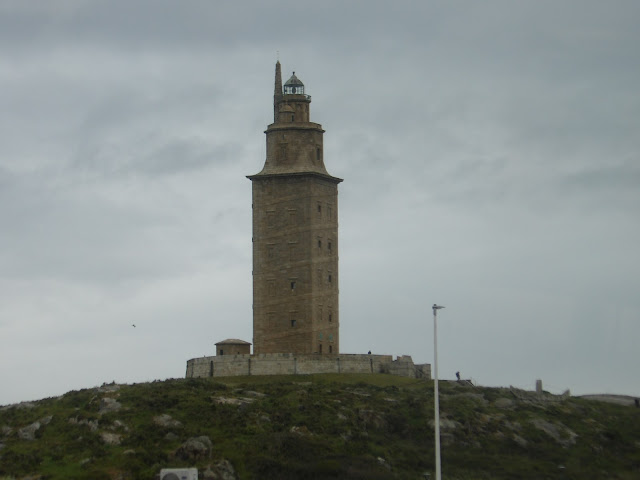Tolin's 2024 World Cruise blog posts, Day 115, May 3, 2024, A Coruna, Spain, A Coruna & the Old Town
A Coruña; also informally called just Coruña, is a city and municipality in Galicia, Spain. It is Galicia's second largest city, behind Vigo. The city is the provincial capital of the province of A Coruña, having also served as political capital of the Kingdom of Galicia from the 16th to the 19th centuries, and as a regional administrative centre between 1833 and 1982.
https://en.wikipedia.org/wiki/A_Coru%c3%b1a
City Hall
Galicia has a wealth of buildings featuring most of the architectural styles found in Europe ranging from neo-classical and baroque to Romanesque and renaissance. But the region also has a particular approach to constructing balconies known locally as "galerias" and A Coruna city must be the district's capitol when it comes to these design features.
A galeria is nothing more than a balcony, but one that is enclosed in a glass frame protecting it from Galicia's cool winters and making it usable all year round. Galerias can appear at first floor level, or on the six floor of a six storey building and there are many variances on the basic design. Those in shot to the right are on Marina Avenue which overlooks the bay of Coruna.
The reason galerias are so prevalent and significant in A Coruna is two fold. Firstly, unlike Galicia's other provincial capitols, a large part of the city is "modernist" and was built in the late nineteenth and early twentieth centuries – the galeria design was especially popular during this period. Secondly, the original fisherman's houses (that lined the harbour and port) were built with galerias and subsequent structures that replaced, or were added to them continued this style.
http://www.galiciaguide.com/Coruna-glass-city.html
The Tower of Hercules is the oldest known extant Roman lighthouse. Built in the 1st century, the tower is located on a peninsula about 1.5 miles from the center of A Coruña, Galicia, in northwestern Spain. Until the 20th century, it was known as the Farum Brigantium. The Latin word farum is derived from the Greek Φάρος, Pharos, for the Lighthouse of Alexandria. The structure stands 180 feet tall and overlooks the North Atlantic coast of Spain. The tower was renovated in 1791.
The Tower of Hercules is a National Monument of Spain and has been a UNESCO World Heritage Site since 27 June 2009. It is the second-tallest lighthouse in Spain, after the Faro de Chipiona.
The tower is known to have existed by the 1st century, built or perhaps rebuilt under Trajan, possibly on foundations following a design that was Phoenician in origin. The design was based on the original plans of the Lighthouse of Alexandria. Its base preserves a cornerstone with the inscription MARTI AVG.SACR C.SEVIVS LVPVS ARCHITECTVS ÆMINIENSIS LVSITANVS.EX.VO, ascribing the tower's design to the architect Gaius Sevius Lupus, from Aeminium (present-day Coimbra, Portugal) in the former province of Lusitania, as an offering to the Roman god of war, Mars. The tower has been in consistent use since the 2nd century. The original tower was shorter and wider than the current tower, as the surviving core was surrounded by a spiral ramp. The outline of this ramp is still visible in the restored exterior. The final story of the tower was likely topped with a dome.
There is sculpture garden on the grounds of the lighthouse featuring works by Pablo Serrano and Francisco Leiro.














Comments
Post a Comment